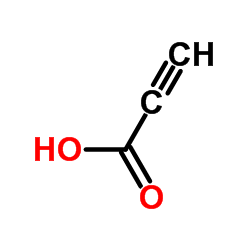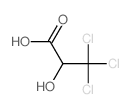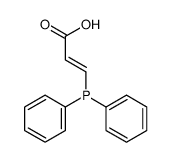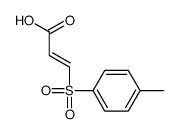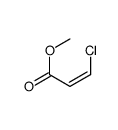2345-61-1
| 中文名 | 反-3-氯丙烯酸 |
|---|---|
| 英文名 | 3-chloroacrylic acid |
| 中文别名 | 反-3-氯烯丙酸 |
| 英文别名 |
TRANS-3-CHLOROPROPENOIC ACID
trans-3-Chloroacrylic acid cis-3-chloro acrylic acid 3-cischloroacrylic acid 3-chloroarylic acid MFCD00064237 Acrylic acid, 3-chloro-, trans- (e)-3-chloro-2-propenoicacid (2E)-3-Chloro-2-propenoic acid EINECS 219-070-0 |
| 密度 | 1.371g/cm3 |
|---|---|
| 沸点 | 192.3ºC at 760mmHg |
| 熔点 | 82-85ºC |
| 分子式 | C3H3ClO2 |
| 分子量 | 106.50800 |
| 闪点 | 70.1ºC |
| 精确质量 | 105.98200 |
| PSA | 37.30000 |
| LogP | 0.82350 |
| 外观性状 | Powder or Flakes | Light gray to beige-gray |
| 蒸汽压 | 0.216mmHg at 25°C |
| 折射率 | 1.4100 (estimate) |
| 储存条件 | 保持容器密封,放入紧密的出藏器内,储存在阴凉,干燥的地方 |
| 稳定性 | 避免氧化物,碱接触, |
| 水溶解性 | Soluble in water. |
| 分子结构 | 1、 摩尔折射率:22.41 2、 摩尔体积(cm3/mol):77.6 3、 等张比容(90.2K):198.9 4、 表面张力(dyne/cm):43.0 5、 极化率(10-24cm3):8.88 |
| 计算化学 | 1、 计疏水参数计算参考值(XlogP):0.7 2、 氢键供体数量:1 3、 氢键受体数量:2 4、 可旋转化学键数量:1 5、 互变异构体数量: 6、 拓扑分子极性表面积(TPSA):37.3 7、 重原子数量:6 8、 表面电荷:0 9、 复杂度:76.9 10、同位素原子数量:0 11、确定原子立构中心数量:0 12、不确定原子立构中心数量:0 13、确定化学键立构中心数量:1 14、不确定化学键立构中心数量:0 15、共价键单元数量:1 |
| 更多 | 1. 性状:带白色的薄片 2. 密度(g/L,20ºC):未确定 3. 相对蒸汽密度(g/mL,空气=1):未确定 4. 熔点(ºC):86 5. 沸点(ºC,常压):9418 6. 沸点(ºC 10mmHg):未确定 7. 折射率(nD20):未确定 8. 闪点(ºF):未确定 9. 比旋光度():未确定 10. 自燃点或引燃温度(ºC):未确定 11. 蒸气压(Pa,20ºC):未确定 12. 饱和蒸气压(kPa,20ºC):未确定 13. 燃烧热(KJ/mol):未确定 14. 临界温度(ºC):未确定 15. 临界压力(KPa):未确定 16. 油水(辛醇/水)分配系数的对数值:未确定 17. 爆炸上限(%,V/V):未确定 18. 爆炸下限(%,V/V):未确定 19. 溶解性:未确定 |
Synonym:Trans-3-Chloroacrylic Acid; (E)-3-Chloro-2-Propenoic Acid Section 2 - COMPOSITION, INFORMATION ON INGREDIENTS
Risk Phrases: 34 Section 3 - HAZARDS IDENTIFICATION EMERGENCY OVERVIEW
Causes burns.Corrosive.Lachrymator (substance which increases the flow of tears). Potential Health Effects Eye: Causes eye burns. Lachrymator (substance which increases the flow of tears). May cause chemical conjunctivitis and corneal damage. Skin: Causes skin burns. May cause skin rash (in milder cases), and cold and clammy skin with cyanosis or pale color. Ingestion: May cause severe and permanent damage to the digestive tract. Causes gastrointestinal tract burns. May cause perforation of the digestive tract. The toxicological properties of this substance have not been fully investigated. May cause systemic effects. Inhalation: May cause severe irritation of the respiratory tract with sore throat, coughing, shortness of breath and delayed lung edema. Causes chemical burns to the respiratory tract. The toxicological properties of this substance have not been fully investigated. Aspiration may lead to pulmonary edema. May cause systemic effects. Chronic: Effects may be delayed. Section 4 - FIRST AID MEASURES Eyes: Get medical aid. Do NOT allow victim to rub eyes or keep eyes closed. Extensive irrigation with water is required (at least 30 minutes). Skin: Get medical aid immediately. Immediately flush skin with plenty of water for at least 15 minutes while removing contaminated clothing and shoes. Wash clothing before reuse. Destroy contaminated shoes. Ingestion: Do not induce vomiting. If victim is conscious and alert, give 2-4 cupfuls of milk or water. Never give anything by mouth to an unconscious person. Get medical aid immediately. Inhalation: Get medical aid immediately. Remove from exposure and move to fresh air immediately. If not breathing, give artificial respiration. If breathing is difficult, give oxygen. Do NOT use mouth-to-mouth resuscitation. If breathing has ceased apply artificial respiration using oxygen and a suitable mechanical device such as a bag and a mask. Notes to Physician: Section 5 - FIRE FIGHTING MEASURES General Information: As in any fire, wear a self-contained breathing apparatus in pressure-demand, MSHA/NIOSH (approved or equivalent), and full protective gear. During a fire, irritating and highly toxic gases may be generated by thermal decomposition or combustion. Use water spray to keep fire-exposed containers cool. Use extinguishing media appropriate to the surrounding fire. Substance is noncombustible. Contact with metals may evolve flammable hydrogen gas. Containers may explode when heated. Extinguishing Media: Do NOT get water inside containers. For small fires, use dry chemical, carbon dioxide, or water spray. For large fires, use dry chemical, carbon dioxide, alcohol-resistant foam, or water spray. Cool containers with flooding quantities of water until well after fire is out. Section 6 - ACCIDENTAL RELEASE MEASURES General Information: Use proper personal protective equipment as indicated in Section 8. Spills/Leaks: Vacuum or sweep up material and place into a suitable disposal container. Avoid runoff into storm sewers and ditches which lead to waterways. Clean up spills immediately, observing precautions in the Protective Equipment section. Avoid generating dusty conditions. Provide ventilation. Section 7 - HANDLING and STORAGE Handling: Wash thoroughly after handling. Use with adequate ventilation. Minimize dust generation and accumulation. Avoid contact with eyes, skin, and clothing. Do not breathe dust, vapor, mist, or gas. Keep container tightly closed. Avoid ingestion and inhalation. Discard contaminated shoes. Storage: Keep container closed when not in use. Store in a cool, dry, well-ventilated area away from incompatible substances. Corrosives area. Section 8 - EXPOSURE CONTROLS, PERSONAL PROTECTION Engineering Controls: Facilities storing or utilizing this material should be equipped with an eyewash facility and a safety shower. Use adequate ventilation to keep airborne concentrations low. Exposure Limits CAS# 2345-61-1: Personal Protective Equipment Eyes: Wear appropriate protective eyeglasses or chemical safety goggles as described by OSHA's eye and face protection regulations in 29 CFR 1910.133 or European Standard EN166. Skin: Wear appropriate protective gloves to prevent skin exposure. Clothing: Wear appropriate protective clothing to prevent skin exposure. Respirators: A respiratory protection program that meets OSHA's 29 CFR 1910.134 and ANSI Z88.2 requirements or European Standard EN 149 must be followed whenever workplace conditions warrant respirator use. Section 9 - PHYSICAL AND CHEMICAL PROPERTIES Physical State: Crystals Color: beige grey Odor: none reported pH: Not available. Vapor Pressure: Not available. Viscosity: Not available. Boiling Point: Not available. Freezing/Melting Point: 81.00 - 83.00 deg C Autoignition Temperature: Not applicable. Flash Point: Not applicable. Explosion Limits, lower: Not available. Explosion Limits, upper: Not available. Decomposition Temperature: Solubility in water: Specific Gravity/Density: Molecular Formula: C3H3ClO2 Molecular Weight: 106.51 Section 10 - STABILITY AND REACTIVITY Chemical Stability: Stable at room temperature in closed containers under normal storage and handling conditions. Conditions to Avoid: Incompatible materials, dust generation, excess heat. Incompatibilities with Other Materials: Oxidizing agents. Hazardous Decomposition Products: Hydrogen chloride, carbon monoxide, irritating and toxic fumes and gases, carbon dioxide. Hazardous Polymerization: Has not been reported Section 11 - TOXICOLOGICAL INFORMATION RTECS#: CAS# 2345-61-1: AS5960000 LD50/LC50: Not available. Carcinogenicity: Trans-3-Chloroacrylic Acid - Not listed by ACGIH, IARC, or NTP. Other: See actual entry in RTECS for complete information. Section 12 - ECOLOGICAL INFORMATION Section 13 - DISPOSAL CONSIDERATIONS Dispose of in a manner consistent with federal, state, and local regulations. Section 14 - TRANSPORT INFORMATION IATA Shipping Name: CORROSIVE SOLID, ACIDIC, ORGANIC, N.O.S.* Hazard Class: 8 UN Number: 3261 Packing Group: II IMO Shipping Name: CORROSIVE SOLID, ACIDIC, ORGANIC, N.O.S. Hazard Class: 8 UN Number: 3261 Packing Group: II RID/ADR Shipping Name: CORROSIVE SOLID, ACIDIC, ORGANIC, N.O.S. Hazard Class: 8 UN Number: 3261 Packing group: II Section 15 - REGULATORY INFORMATION European/International Regulations European Labeling in Accordance with EC Directives Hazard Symbols: C Risk Phrases: R 34 Causes burns. Safety Phrases: S 24/25 Avoid contact with skin and eyes. S 26 In case of contact with eyes, rinse immediately with plenty of water and seek medical advice. S 28A After contact with skin, wash immediately with plenty of water. S 37 Wear suitable gloves. S 45 In case of accident or if you feel unwell, seek medical advice immediately (show the label where possible). WGK (Water Danger/Protection) CAS# 2345-61-1: No information available. Canada None of the chemicals in this product are listed on the DSL/NDSL list. CAS# 2345-61-1 is not listed on Canada's Ingredient Disclosure List. US FEDERAL TSCA CAS# 2345-61-1 is not listed on the TSCA inventory. It is for research and development use only. SECTION 16 - ADDITIONAL INFORMATION N/A |
|
毒理学数据: 1、急性毒性:小鼠静脉LD50:180mg/kg 生态学数据: 对水是稍微有害的,不要让未稀释或大量的产品接触地下水,水道或者污水系统,若无政府许可,勿将材料排入周围环境 CHEMICAL IDENTIFICATION
HEALTH HAZARD DATAACUTE TOXICITY DATA
|
| 危害码 (欧洲) | C:Corrosive; |
|---|---|
| 风险声明 (欧洲) | R34 |
| 安全声明 (欧洲) | S24/25 |
| 危险品运输编码 | UN 3261 8/PG 2 |
| WGK德国 | 3 |
| RTECS号 | AS5960000 |
| 包装等级 | II |
|
~% 
2345-61-1 |
| 文献:Recueil des Travaux Chimiques des Pays-Bas, , vol. 54, p. 168 |
|
~43% 
2345-61-1 |
| 文献:Durig; Drew; Reese; Brletic Spectrochimica acta. Part A, Molecular and biomolecular spectroscopy, 2000 , vol. 56 A, # 11 p. 2091 - 2106 |
|
~30% 
2345-61-1 |
| 文献:Wolf, Reinhard; Steckhan, Eberhard Journal of the Chemical Society, Perkin Transactions 1: Organic and Bio-Organic Chemistry (1972-1999), 1986 , p. 733 - 740 |
|
~% 
2345-61-1 |
| 文献:Recueil des Travaux Chimiques des Pays-Bas, , vol. 54, p. 168 Bulletin de la Societe Chimique de France, , p. 593,596 |
|
~% 
2345-61-1 |
| 文献:Synthetic Communications, , vol. 34, # 4 p. 657 - 664 |
|
~% 
2345-61-1 |
| 文献:Khimicheskaya Nauka i Promyshlennost, , vol. 3, p. 834 Chem.Abstr., , p. 10021 |
|
~% 
2345-61-1 |
| 文献:Recueil des Travaux Chimiques des Pays-Bas, , vol. 54, p. 168 |
|
~% 
2345-61-1 |
| 文献:Recueil des Travaux Chimiques des Pays-Bas, , vol. 54, p. 168 |
|
~% 
2345-61-1 |
| 文献:Bulletin de la Societe Chimique de France, , p. 593,596 |
| 上游产品 5 | |
|---|---|
| 下游产品 7 | |


